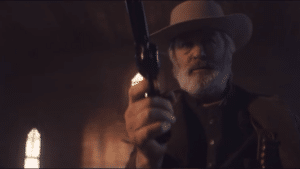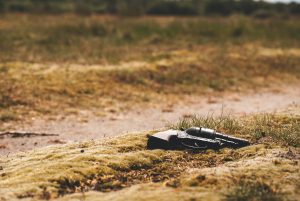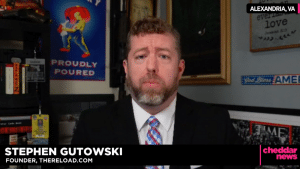In his first major interview since being involved in a fatal shooting on the set of his latest movie, Alec Baldwin made a surprising new claim about his actions that day.
Baldwin said the gun went off without him ever actually pulling its trigger.
“Well, the trigger wasn’t pulled,” he told ABC News. “I didn’t pull the trigger.”
At first glance, this sounds far-fetched. It is exceedingly rare for a gun to fire without the trigger being depressed. Modern firearms, even replicas of antique guns, have safeties specifically designed to prevent them from firing without the trigger being pulled. It only really happens when the gun’s firing mechanism is damaged, or there is a significant design flaw.
That’s why most gun owners and firearms safety trainers are highly skeptical of any claim a gun just “went off” absent user error.
In Baldwin’s case, though, the claim is at least somewhat more believable. That’s because the gun involved is more prone to firing without the trigger being pulled. And, even though it’s a modern replica of an antique design, it’s possible it did not include modern safety devices.
Santa Fe County Sheriff Adan Mendoza identified the gun used in the shooting as a modern Pietta replica of a single-action army revolver. Those guns can be bought either with a transfer bar that makes it impossible for the firing pin to strike the primer unless the trigger is pulled or without one. Often, enthusiasts and collectors prefer the models without modern safety devices because it’s more authentic and perfectly safe when handled properly.
A single-action revolver usually requires the hammer to be manually cocked, and the trigger be pulled for a shot to be fired. That’s why it’s referred to as a single-action: because the trigger performs just one action. It drops the hammer. In a double-action revolver, on the other hand, the trigger can both cock and release the hammer.
However, a single-action revolver with the old-style firing mechanism can fire without either the hammer being cocked or the trigger being pulled. When the hammer is down on that kind of revolver, the firing pin protrudes and, if a live round is loaded in the chamber underneath, a sharp enough jolt can cause the pin to strike the round’s primer with enough force to set it off.
This is why the “cowboy load” was developed. When carrying an old-style single-action revolver, it’s best practice to leave the chamber underneath the hammer unloaded. That way, a jolt can’t unintentionally set off a round.
None of that means Baldwin’s story is entirely accurate. It’s not clear if drawing a gun from a holster in this state would be enough to set it off. It still seems more plausible Baldwin pulled the trigger. But, the gun firing without the trigger being pulled is not as far-fetched as it sounds at first.
Police should be able to determine what kind of firing mechanism the gun in question has and whether it could have fired in the way Baldwin described. However, even if the gun did go off without the trigger being pulled, it doesn’t negate the other negligence that contributed to the deadly shooting.
There is a reason the basic gun safety rules are redundant. You’re never supposed to put your finger on the trigger until you’re ready to fire. You’re never supposed to assume a gun is unloaded. You’re never supposed to point a gun at anything you don’t want to shoot.
Had they all been followed, it is unlikely this shooting would have turned deadly. But, as the numerous prior negligent discharges on set and Baldwin’s other comments reveal, basic safety rules were not followed.
“I would never point a gun at anyone and pull the trigger at them,” Baldwin said.
That sentence went on six words too long. Even on a movie set, you shouldn’t be pointing a gun at anyone. Most sets have protocols in place to avoid scenarios like that. Most also have protocols to ensure a gun is never loaded with any round it isn’t supposed to be. And most would never allow live ammunition on set while filming.
There was a string of negligent acts that led to the death of a colleague, wife, and mother. Even if Baldwin never pulled the trigger, a cascade of avoidable mistakes was necessary for this tragedy to unfold. There remains plenty of blame to go around.
UPDATE 12-2-2021 9:33 PM: Alec Baldwin offered further details on how the deadly shooting occurred in the full ABC News interview. Baldwin claims he acted at the direction of cinematographer Halyna Hutchins when he accidentally shot and killed her.
“I cock the gun. I go, ‘Can you see that? Can you see that? Can you see that?’” Baldwin told ABC. “And then I let go of the hammer of the gun, and the gun goes off. I let go of the hammer of the gun, the gun goes off.”
This version of events is even more difficult to square with the idea that Baldwin never pulled the trigger.
When the hammer is pulled back on a single-action revolver a series of sears are engaged which prevent it from moving back towards the chamber without the trigger being depressed. There are scenarios where the gun might be able to fire after the hammer is pulled back but without the trigger being pulled. However, they’re even more unlikely than a discharge with the hammer all the way down.
The first is that Baldwin managed to pull the hammer back far enough that releasing created a strong enough strike against the primer to set it off, but not far enough to engage the sear at quarter or half cock. That is, frankly, implausible.
The next possibility is a physical defect with the gun. The sears could have been so worn out they don’t catch the hammer as Baldwin manipulates it. But, that’s not likely either since it would be clear to anyone who handled the gun that it was broken.
What seems far more likely is Baldwin kept the trigger depressed as he pulled the hammer back. Then, when he released the hammer, the trigger kept the sears out of the way, and the gun fired. Perhaps Baldwin is making some kind of semantic argument about pulling a trigger rather than keeping it depressed while cocking the hammer, but that’s a distinction without a difference.
The most likely scenario remains that Baldwin had his finger on the trigger when the gun fired. His full comments make that even more likely.







10 Responses
WOW! That’s quite a stretch!
Which part?
That Baldwin stated he didn’t pull the trigger. I’d like to see the odds of that “:not” happening.
I agree it’s not likely. And, the scenario he describes in his full comments makes it even less likely.
Looks like someone copied your writing “word-for-word”:
https://neonnettle.com/news/17614-alec-baldwin-doesn-t-feel-guilty-for-shooting-someone-else-is-responsible-not-me-
Never mind, my bad. You got the creds.
Steven, makes me wondering if the draw called for cocking the pistol as he drew it. Ifhis thumb slipped and the 1/2 cock was worn that could of set off a rnd. Add that to bad luck, piss poor chamber checking, and you have tragedy.
I was not impressed with the stories I read on “spinning the cylinder” as a chamber check. Unless the dummies had an empty primer pocket that seems practically worthless.
Actually spinning it slowly would inform them if every chamber was empty but if so holy crap they did a bad job.
It’s possible if the sears are damaged. That seems unlikely, though, as it would be pretty apparent to anyone handling the gun.
Also, dummy rounds are supposed to have a visual indicator that they’re dummies. Dimpled or missing primers are one of the main ways armorers do that. But, it’s not clear how things were handled on this set yet.
Every model of the F.LLI Pietta 1873 SA Revolver I can find online states they have transfer bars… And so if they were using a model without transfer bars that in itself is a major safety oversight! Additionally, number 1 gun safety rule— the gun is always loaded. Number 2— always verify for yourself the gun isn’t loaded, never rely on what someone tells you or even if you saw them check it just prior to handing it to you. You still verify for yourself once the gun is in your hands. That’s the most basic fundamentals of gun safety.
“F.LLI Pietta 1873 SA Revolvers are faithful re-creations of the venerable 1873 Colt® Single-Action Army revolvers, also known as Peacemakers or simply Colt 45s. To help celebrate Pietta’s 50 years of success and Cabela’s long partnership in excellence with Pietta, we’re offering special versions of the legendary 1873 Single-Action Army chambered in .357 Magnum, .44 Magnum and .45 Long Colt. Models sport handsome grips, premium finishes, six-shot cylinders, authentic fixed sights and round barrels. Transfer bars provide safe, reliable operation.”